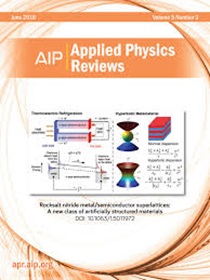Rapidly synthesized laser-induced graphene and its derivatives for miniaturized energy devices: Principles, applications, and challenges
IF 11.6
1区 物理与天体物理
Q1 PHYSICS, APPLIED
引用次数: 0
Abstract
This review highlights the latest progress in the field of graphene synthesis, with a focus on laser-induced graphene (LIG) and its growing applications in flexible and miniaturized energy storage devices, particularly supercapacitors. Graphene has remarkable electrical, thermal, and mechanical properties that have attracted significant attention. However, conventional production techniques, such as chemical vapor deposition (CVD) and mechanical exfoliation, face challenges related to scalability and environmental impact. LIG emerges as a viable alternative, offering a rapid, eco-friendly, and scalable approach to graphene production. LIG provides precise control over material properties by employing direct laser irradiation on carbon-based precursors. This review further explores various laser systems, including CO2 and visible light lasers, applied to substrates such as polyimide, paper, and cloth. It investigates how factors like laser power, scanning speed, and substrate type affect graphene quality. Furthermore, the review examines the integration of LIG into energy storage technologies, highlighting its flexibility, high conductivity, and extensive surface area. It also addresses enhancing LIG properties through doping with elements like boron, nitrogen, and sulfur and incorporating nanoparticles such as silver and cobalt into LIG-based composites. Furthermore, detailed discussions are provided on how these modifications improve supercapacitor performance, specifically regarding areal capacitance, energy density, and storage capacity. These advancements underscore the versatility of LIG and its potential for application in various substrates.用于小型能源装置的快速合成激光诱导石墨烯及其衍生物:原理、应用和挑战
本文综述了石墨烯合成领域的最新进展,重点介绍了激光诱导石墨烯(LIG)及其在柔性和小型化储能器件,特别是超级电容器中的应用。石墨烯具有显著的电学、热学和力学性能,引起了人们的极大关注。然而,传统的生产技术,如化学气相沉积(CVD)和机械剥落,面临着与可扩展性和环境影响相关的挑战。LIG作为一种可行的替代方案,为石墨烯生产提供了快速、环保和可扩展的方法。LIG通过对碳基前体进行直接激光照射,提供对材料性能的精确控制。本文进一步探讨了各种激光系统,包括CO2和可见光激光器,应用于聚酰亚胺,纸和布等基材。研究了激光功率、扫描速度和衬底类型等因素对石墨烯质量的影响。此外,该综述探讨了LIG与储能技术的集成,突出了其灵活性,高导电性和广泛的表面积。它还通过掺杂硼、氮和硫等元素,以及将银和钴等纳米颗粒掺入到ligg基复合材料中,来提高LIG的性能。此外,还详细讨论了这些改进如何提高超级电容器的性能,特别是关于面电容、能量密度和存储容量。这些进步强调了LIG的多功能性及其在各种衬底上的应用潜力。
本文章由计算机程序翻译,如有差异,请以英文原文为准。
求助全文
约1分钟内获得全文
求助全文
来源期刊

Applied physics reviews
PHYSICS, APPLIED-
CiteScore
22.50
自引率
2.00%
发文量
113
审稿时长
2 months
期刊介绍:
Applied Physics Reviews (APR) is a journal featuring articles on critical topics in experimental or theoretical research in applied physics and applications of physics to other scientific and engineering branches. The publication includes two main types of articles:
Original Research: These articles report on high-quality, novel research studies that are of significant interest to the applied physics community.
Reviews: Review articles in APR can either be authoritative and comprehensive assessments of established areas of applied physics or short, timely reviews of recent advances in established fields or emerging areas of applied physics.
 求助内容:
求助内容: 应助结果提醒方式:
应助结果提醒方式:


